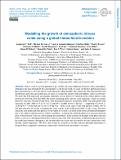Modelling the growth of atmospheric nitrous oxide using a global hierarchical inversion
Author(s)
Stell, Angharad C; Bertolacci, Michael; Zammit-Mangion, Andrew; Rigby, Matthew; Fraser, Paul J; Harth, Christina M; Krummel, Paul B; Lan, Xin; Manizza, Manfredi; Mühle, Jens; O'Doherty, Simon; Prinn, Ronald G; Weiss, Ray F; Young, Dickon; Ganesan, Anita L; ... Show more Show less
DownloadPublished version (5.264Mb)
Publisher with Creative Commons License
Publisher with Creative Commons License
Creative Commons Attribution
Terms of use
Metadata
Show full item recordAbstract
<jats:p>Abstract. Nitrous oxide is a potent greenhouse gas (GHG) and ozone-depleting substance, whose atmospheric abundance has risen throughout the contemporary record. In this work, we carry out the first global hierarchical Bayesian inversion to solve for nitrous oxide emissions, which includes prior emissions with truncated Gaussian distributions and Gaussian model errors, in order to examine the drivers of the atmospheric surface growth rate. We show that both emissions and climatic variability are key drivers of variations in the surface nitrous oxide growth rate between 2011 and 2020. We derive increasing global nitrous oxide emissions, which are mainly driven by emissions between 0 and 30∘ N, with the highest emissions recorded in 2020. Our mean global total emissions for 2011–2020 of 17.2 (16.7–17.7 at the 95 % credible intervals) Tg N yr−1, comprising of 12.0 (11.2–12.8) Tg N yr−1 from land and 5.2 (4.5–5.9) Tg N yr−1 from ocean, agrees well with previous studies, but we find that emissions are poorly constrained for some regions of the world, particularly for the oceans. The prior emissions used in this and other previous work exhibit a seasonal cycle in the extra-tropical Northern Hemisphere that is out of phase with the posterior solution, and there is a substantial zonal redistribution of emissions from the prior to the posterior. Correctly characterizing the uncertainties in the system, for example in the prior emission fields, is crucial for deriving posterior fluxes that are consistent with observations. In this hierarchical inversion, the model-measurement discrepancy and the prior flux uncertainty are informed by the data, rather than solely through “expert judgement”. We show cases where this framework provides different plausible adjustments to the prior fluxes compared to inversions using widely adopted, fixed uncertainty constraints.
</jats:p>
Date issued
2022Department
Massachusetts Institute of Technology. Department of Earth, Atmospheric, and Planetary SciencesJournal
Atmospheric Chemistry and Physics
Publisher
Copernicus GmbH
Citation
Stell, Angharad C, Bertolacci, Michael, Zammit-Mangion, Andrew, Rigby, Matthew, Fraser, Paul J et al. 2022. "Modelling the growth of atmospheric nitrous oxide using a global hierarchical inversion." Atmospheric Chemistry and Physics, 22 (19).
Version: Final published version